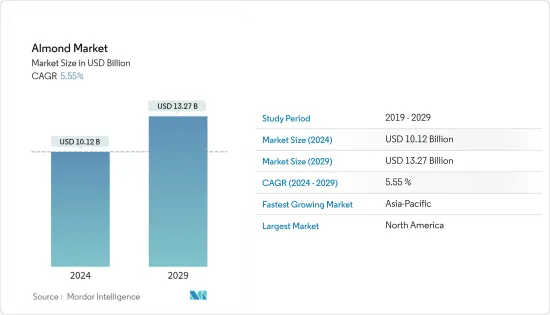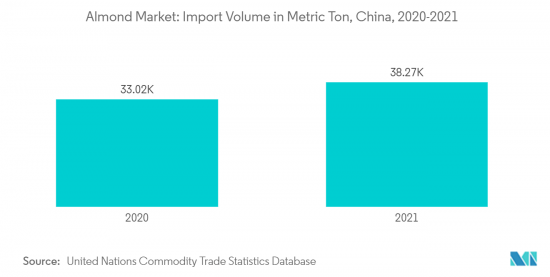PUBLISHER: Mordor Intelligence | PRODUCT CODE: 1406176

PUBLISHER: Mordor Intelligence | PRODUCT CODE: 1406176
Almond - Market Share Analysis, Industry Trends & Statistics, Growth Forecasts 2024 - 2029

The Almond Market size is estimated at USD 10.12 billion in 2024, and is expected to reach USD 13.27 billion by 2029, growing at a CAGR of 5.55% during the forecast period (2024-2029).
Key Highlights
- Aligning with an escalating consumer need for transparency, plant-forward innovation, holistic and individualized nutrition, and delicious sensory experiences, almonds continue to have undeniable consumer appeal as food and beverage trends evolve. The high presence of minerals and nutrients makes almonds a more versatile and healthy ingredient added to different types of food applications, providing rich nutritional value to consumers. However, the high cost of production, resulting in the commodity's expensive nature, has hindered consumption during the economic uncertainty in different developing countries.
- Further, according to the Food and Agriculture Organization (FAO), the United States is the primary producer of almonds, followed by Spain, Iran, and Australia. The favorable climate with fertile soil and abundant sunshine and the required equipment to be used during growth, harvesting, processing, and packaging in North America favor the enhanced production of almonds. Thus, with increasing demand owing to the health benefits and increased health awareness, the market is anticipated to grow during the forecast period.
Almond Market Trends
Growing Inclination Towards Healthy Snacking
Tree nuts, especially almonds, consumed two or more times per week were linked to a 13% lower risk of total cardiovascular disease and a 15% lower risk of coronary heart disease, according to primary epidemiological research by health professionals who examined general nut intake. The preference for healthy and nutritious snack foods is expected to help maintain steady growth in developed markets such as China and the United States, as evident from the increased imports and eventual consumption. The changing consumer lifestyle, rapid urbanization, and high disposable income increase the demand for on-the-go healthy convenience foods, fueling the ready-to-eat food market's growth. Rapid urbanization and rising disposable income encourage changes in food consumption habits and a greater willingness to spend on such foods.These factors further boost the food expenditure of the final consumer.
Moreover, manufacturers are launching innovative and health-oriented products consisting of almonds, either as a whole or as an ingredient, thus expanding their business in the global healthy snack segment. These products are gaining popularity among vegans and highly health-conscious consumers. For instance, in March 2021, PepsiCo introduced Hilo Life, a low-carb snack brand in North America, using defatted almond flour as a base ingredient. According to the company, this new product has less fat and more protein than traditional almond flour.

North America is Leading the Market in Terms of Production
Due to more production, consumption, and exports, North America has the largest share of the world's almond market.The United States continues to capture the largest market share for almonds. According to the Food and Agricultural Organization, almond production in 2020 will account for 4,140,043.0 metric tons, a 35.1% increase over previous years.However, the average number of nuts set per tree has declined by 12 percent in 2021-2022, more than compensating for an increase in bearing acres of 4 percent and resulting in an anticipated 11 percent decline in U.S. production to 1.2 million tons, according to the United States Department of Agriculture report. Even though the harvest began with good pollination conditions, warm temperatures led to a shorter bloom time than in previous years. Additionally, there are claims that some areas experienced a freeze in the final week of February, which left some acres unharvested due to an inadequate nut set, resulting in a decline in production.
Also, the United Nations Commodity Trade Statistics Database says that Spain, Germany, the Netherlands, Japan, and the United Arab Emirates will import more than half of the almonds from the United States in 2021. Almonds are mostly grown in the United States, but Australia, Spain, and Vietnam also send almonds to the US market to meet the growing demand there. Due to their health benefits, almond-based snacks are becoming more and more popular in the area. The rising demand for highly nutritious foods and the concerns of a significant population with a high rate of obesity have been some of the main reasons behind the market's growth over the past few years. The favorable climate in North America with fertile soil and abundant sunshine and the required equipment to be used during growth, harvesting, processing, and packaging favor the enhanced production of almonds.
Additional Benefits:
- The market estimate (ME) sheet in Excel format
- 3 months of analyst support
TABLE OF CONTENTS
1 INTRODUCTION
- 1.1 Study Assumptions and Market Definition
- 1.2 Scope of the Study
2 RESEARCH METHODOLOGY
3 EXECUTIVE SUMMARY
4 MARKET DYNAMICS
- 4.1 Market Overview
- 4.2 Market Drivers
- 4.3 Market Restraints
- 4.4 Supply Chain/Value Chain Analysis
5 MARKET SEGMENTATION Production Analysis (Volume), Consumption Analysis (Value and Volume), Export Analysis (Value and Volume), Import Analysis (Value and Volume), and Price Trend Analysis.
- 5.1 Geography
- 5.1.1 North America
- 5.1.1.1 United States
- 5.1.2 Europe
- 5.1.2.1 Spain
- 5.1.2.2 Italy
- 5.1.2.3 Portugal
- 5.1.2.4 Greece
- 5.1.3 Asia-Pacific
- 5.1.3.1 Iran
- 5.1.3.2 Turkey
- 5.1.3.3 Australia
- 5.1.3.4 China
- 5.1.3.5 India
- 5.1.3.6 Vietnam
- 5.1.4 South America
- 5.1.4.1 Chile
- 5.1.4.2 Argentina
- 5.1.5 Middle-East and Africa
- 5.1.5.1 Morocco
- 5.1.5.2 Tunisia
- 5.1.5.3 Saudi Arabia
- 5.1.5.4 Egypt
- 5.1.1 North America
6 MARKET OPPORTUNITIES AND FUTURE TRENDS




